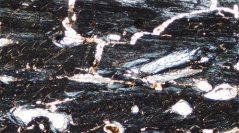

 Comptes Rendus Palevol
21 (29) - Pages 619-679
Comptes Rendus Palevol
21 (29) - Pages 619-679Shell suture obliteration (ankylosis) was exceptionally frequent in the earliest turtles, in contrast to post-Triassic taxa. Since modern turtles grow mostly along sutures, early ankylosis in Triassic taxa is intriguing. The Triassic turtle Proterochersis porebensis Szczygielski & Sulej, 2016 is known from numerous specimens, allowing observation of shell microstructure changes during ontogeny. Shell ankylosis occurred seemingly randomly in individuals of variable size, including small and morphologically juvenile, and completely obscured the initial bony composition. We propose that this phenomenon in the Triassic turtles can be an effect of early evolutionary stages of shell histogenesis and physiological mechanisms still used in shell regeneration in modern species. We also describe some parallels between the unusual peripheral microstructure of another Triassic turtle, Waluchelys cavitesta Sterli, Martínez, Cerda & Apaldetti, 2020, and Proterochersis porebensis. Microstructural changes imply that Proterochersis porebensis could change habitat during ontogeny, small individuals appearing more aquatic and larger more terrestrial.
Shell histology, Triassic, Norian, turtles, ankylosis, shell growth, sutures, carapace, plastron, Testudinata